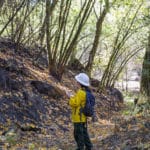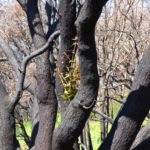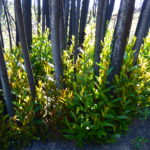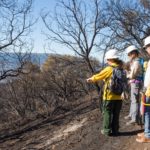December 20, 2018
Posted in: News Articles
Working with partners to reduce fire risk in Sonoma Valley
In the wake of the 2017 Sonoma Complex Fires, a group of conservation organizations and land management agencies has teamed up to collaboratively manage vegetation and fuel loads on properties in the Sonoma Valley region. Ag + Open Space is one of the participating organizations, along with Audubon Canyon Ranch, Sonoma Mountain Ranch Preservation Foundation, Regional Parks, California State Parks, and Sonoma Land Trust. Collectively, this group owns and manages approximately 18,000 acres in Sonoma Valley and the surrounding hills.
Known as the Sonoma Valley Wildlands Collaborative (the Collaborative), this group intends to coordinate vegetation and fuel management activities across these lands, including targeted thinning for forest health and resiliency, construction and maintenance of fuel breaks, and prescribed burning where appropriate for ecosystem health and fuel reduction. The Collaborative will work closely with CAL FIRE to prioritize projects and ensure that they contribute to regional land management and fire protection objectives. CAL FIRE will also be a key partner in implementing any prescribed burns within the Collaborative’s project area.
The Collaborative recognizes that appropriate management of wildland vegetation is key to maintaining the ecological diversity and resiliency of our landscapes, and that a coordinated rather than piecemeal approach can achieve stronger outcomes for our protected natural landscapes. By working together, our organizations can utilize resources and expert consultants more efficiently, achieve continuity of management activities across property boundaries, ensure coordination with regional goals set by agencies such as CAL FIRE, and provide a model for cooperative land management that may be used throughout our community. We anticipate that the Collaborative’s efforts will be complementary to other developing regional efforts in managing for fire safety and ecological health on a broader scale.
Our native vegetation evolved with and is adapted to fire, and many native species require periodic fire in order to reproduce and thrive. Without fire or other regular disturbance, we risk losing biodiversity and habitat, as well as our ecosystem’s ability to adapt to climate change. Without active vegetation management, the build-up of hazardous fuels can lead to more intense and destructive wildfires – a prime consideration where wildlands are in close proximity to cities, towns, and rural residences. In these areas, appropriate management can provide safe access for first responders, keep evacuation routes open, and modulate the impacts of future wildfires on ecosystem health.
The use of prescribed fire mimics natural processes, restoring fire to its historic role in wildland ecosystems under conditions that are carefully selected for optimal public and firefighter safety, smoke dispersal, and fire behavior. It provides multiple, significant ecosystem benefits, including enhancing habitat for plants and animals, reducing invasive species, improving forest health and carbon sequestration, maintaining populations of fire-dependent plant species, improving soil health, and maintaining water quality.
Ag + Open Space is thrilled to participate in the Collaborative because our 1,290-acre Calabazas Creek Open Space Preserve lies within the project area. The 2017 Nuns Fire burned the entirety of the Preserve at low to moderate intensity, and significant opportunities exist for us to build upon the fire’s effects in order to maintain reduced fuel loads, manage invasive species, and improve forest health across the Preserve. Since wildfire knows no jurisdictional boundaries, it is imperative that we work with our conservation partners to jointly manage vegetation across the landscape.
The Sonoma Valley region has experienced repeated, high-severity wildfires in the past, and in all likelihood, it will again. As we have so recently seen, wildfire’s impacts on communities can be tragic, and recovery can be slow for both people and landscapes affected by severe fires. While achieving the Collaborative’s goals will be a long-term effort, the hope is that our collective work will increase resiliency across our protected lands and help protect human safety when wildfire does return to our region. The Collaborative will conduct significant public outreach once specific projects take shape, and we look forward to sharing more details as our plans develop.



